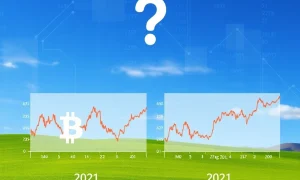For entrepreneurs and investors, understanding market dynamics is crucial. The cryptocurrency world, particularly the Bitcoin cycle, has historically followed a distinct four-year pattern. This cycle often aligns with Bitcoin’s halving events. However, a significant debate now challenges this predictability. Is the traditional Bitcoin cycle truly dead? This question has profound implications for investment strategies and market behavior.
Understanding the Historical Bitcoin Cycle
Historically, crypto markets have moved in predictable four-year bull and bear cycles. These cycles seemingly revolve around the Bitcoin halving. This event reduces the supply of new Bitcoin entering the market. For instance, Bitcoin’s price peaks occurred in 2013, 2017, and 2021. Each peak followed a halving year. Consequently, many expected the next peak in 2025. This pattern has served as a key reference point for investors. It provided a framework for anticipating market movements. Nevertheless, recent developments suggest this pattern might be unraveling.
The halving mechanism cuts the reward for mining new blocks by half. This event occurs approximately every four years. It aims to control Bitcoin’s supply and ensure its scarcity. In previous cycles, this supply shock often preceded significant price rallies. Therefore, many believed the halving was the primary driver of the Bitcoin cycle. Experts like Bluefin community lead Harry Collins still share this outlook. He predicts a bull market top in October based on this historical trend. However, new forces are now influencing the market.
Arguments for the End of the Predictable Bitcoin Cycle
Many industry analysts and experts believe the traditional Bitcoin cycle is nearing its end. The primary reason for this shift is the growing involvement of institutions. Institutional capital flows into crypto are changing market dynamics significantly. For example, author and investor Jason Williams highlighted this change. He stated on X, “Top 100 Bitcoin treasury companies hold almost 1 MILLION Bitcoin.” He concluded, “This is why the Bitcoin 4 year cycle is over.” This substantial accumulation by corporations marks a departure from previous cycles, which were largely retail-driven.
Matthew Hougan, Chief Investment Officer at Bitwise Asset Management, echoes this sentiment. He made similar remarks in a recent CNBC article. Hougan believes the cycle is likely over, though he awaits 2026 returns for official confirmation. His perspective aligns with the idea that institutional money brings greater stability and different market drivers. Furthermore, Bitcoin Exchange-Traded Products (ETPs) are now being added to wealth platforms. This broadens access for traditional investors. This widespread adoption shifts demand dynamics away from mere halving-induced scarcity.
Pierre Rochard, CEO of The Bitcoin Bond Company, also agrees. He stated on X that the four-year cycles seem “more likely than not” to be over. Rochard argues that Bitcoin halvings are “immaterial to trading float.” He explains that 95% of BTC has already been mined. Therefore, current supply largely comes from “buying out OGs” (original holders). Demand, conversely, stems from a combination of factors. These include spot retail interest, ETPs on wealth platforms, and treasury companies. This complex interplay of supply and demand reduces the halving’s singular influence on the Bitcoin cycle.
New Drivers Influencing the Bitcoin Cycle
As the market matures, other factors gain prominence. Martin Burgherr, Chief Clients Officer at Sygnum Bank, emphasizes this point. He told StockPil that the four-year halving cycle remains a useful reference. However, it is “no longer the sole driver of market behavior.” Instead, a confluence of macro drivers now shapes the market. These include:
- Macroeconomic Conditions: Global inflation, interest rates, and geopolitical events increasingly impact crypto prices.
- Institutional Capital Flows: Large-scale investments from funds and corporations provide new demand.
- Regulatory Developments: Government policies and frameworks create certainty or uncertainty for investors.
- ETF Adoption: The approval and widespread use of Bitcoin ETFs integrate crypto into traditional financial portfolios.
Burgherr concludes that the four-year framework is becoming “one of several inputs rather than the market’s central script.” This suggests a more diversified set of influences on the Bitcoin cycle. Consequently, investors must consider a broader range of indicators beyond just the halving.
Defending the Enduring Bitcoin Cycle: A Counter-Narrative
Despite the growing consensus, not everyone believes the four-year Bitcoin cycle is dead. Some prominent analysts argue that the core mechanics of Bitcoin ensure the cycle’s continuation. For example, crypto analyst ‘CRYPTO₿IRB’ strongly disagrees with the notion that the cycle is gone. He told his 715,000 X followers that such a claim is “wrong.”
CRYPTO₿IRB argues that ETFs have actually strengthened the four-year crypto cycles. He points out that traditional finance often operates on four-year presidential cycles. Therefore, ETFs increase the “crypto-tradfi correlation.” This means that as more traditional financial institutions engage with Bitcoin through ETFs, they might inadvertently reinforce existing cyclical patterns. He further emphasized the fundamental aspect of the halving, stating, “Not to mention 4-year halving cycles which simply just can’t be cancelled as they’re mathematically programmed lol.” This highlights the immutable code behind Bitcoin’s supply mechanism.
Similarly, Xapo Bank CEO Seamus Rocca expressed caution in July. He told StockPil that the risk of a prolonged bear market remains very real. He believes the four-year cycles are still intact. Rocca noted, “So many people are saying, ‘Oh, the institutions are here, and, therefore, the cyclical sort of nature of Bitcoin is dead.’ I’m not sure I agree with that.” His perspective suggests that while institutional involvement is significant, it may not completely override Bitcoin’s inherent cyclical nature. The market might still experience periods of extended downturns, similar to past bear phases.
Navigating the Evolving Bitcoin Cycle Landscape
The ongoing debate highlights the evolving nature of the cryptocurrency market. For businesses and investors, adapting to these changes is essential. Whether the four-year Bitcoin cycle is truly dead or merely evolving, a nuanced understanding is required. Investors should consider a balanced approach. This involves acknowledging both the historical patterns and the new market drivers. Diversification of investment strategies becomes increasingly important. Relying solely on past performance may no longer be sufficient in this dynamic environment.
Ultimately, the market is maturing. It integrates more traditional financial elements while retaining its unique digital characteristics. This blend means that macroeconomic conditions, regulatory shifts, and institutional adoption will continue to play a larger role. However, the fundamental halving event still influences supply. Therefore, the future of the Bitcoin cycle might be a hybrid model. It could combine predictable supply shocks with broader market influences. Staying informed about expert opinions and market data will be crucial for navigating this complex landscape.
The question of the four-year Bitcoin cycle remains a central topic of discussion. While some experts confidently declare its demise due to institutional involvement, others maintain its enduring mathematical basis. This ongoing debate reflects the cryptocurrency market’s journey from a niche asset to a globally recognized financial instrument. Ultimately, market participants must consider all perspectives. This allows for informed decisions in an increasingly complex and interconnected financial world.
Frequently Asked Questions (FAQs)
Q1: What is the traditional Bitcoin cycle?
The traditional Bitcoin cycle refers to a four-year pattern of bull and bear markets. This pattern historically aligns with Bitcoin’s halving events. These halvings cut the supply of new Bitcoin by half. Past price peaks occurred roughly one year after each halving, in 2013, 2017, and 2021.
Q2: Why do some experts believe the Bitcoin cycle is dead?
Many experts believe the cycle is dead due to massive institutional adoption. Large corporations and financial institutions are now holding significant amounts of Bitcoin. Additionally, Bitcoin ETFs and ETPs have made crypto more accessible to traditional investors. These factors introduce new demand and supply dynamics, potentially overriding the halving’s singular influence.
Q3: What arguments support the continuation of the Bitcoin cycle?
Proponents of the cycle’s continuation point to Bitcoin’s mathematically programmed halving events. They argue these supply shocks are immutable. Some also suggest that traditional finance, which often operates on four-year cycles, might actually reinforce Bitcoin’s cyclical nature through increased correlation via ETFs.
Q4: How do macroeconomic factors influence the Bitcoin cycle?
As the Bitcoin market matures, it becomes more sensitive to global macroeconomic conditions. Factors like inflation rates, interest rate decisions by central banks, and geopolitical events now play a significant role. These external economic forces can impact investor sentiment and capital flows into crypto, diversifying the drivers of the Bitcoin cycle.
Q5: How should investors adapt to the evolving Bitcoin market?
Investors should adopt a more nuanced approach. This involves considering both the historical halving patterns and new influences like institutional adoption, regulatory changes, and macroeconomic conditions. Diversifying investment strategies and staying informed about a broader range of market indicators are crucial for navigating this evolving landscape.
























